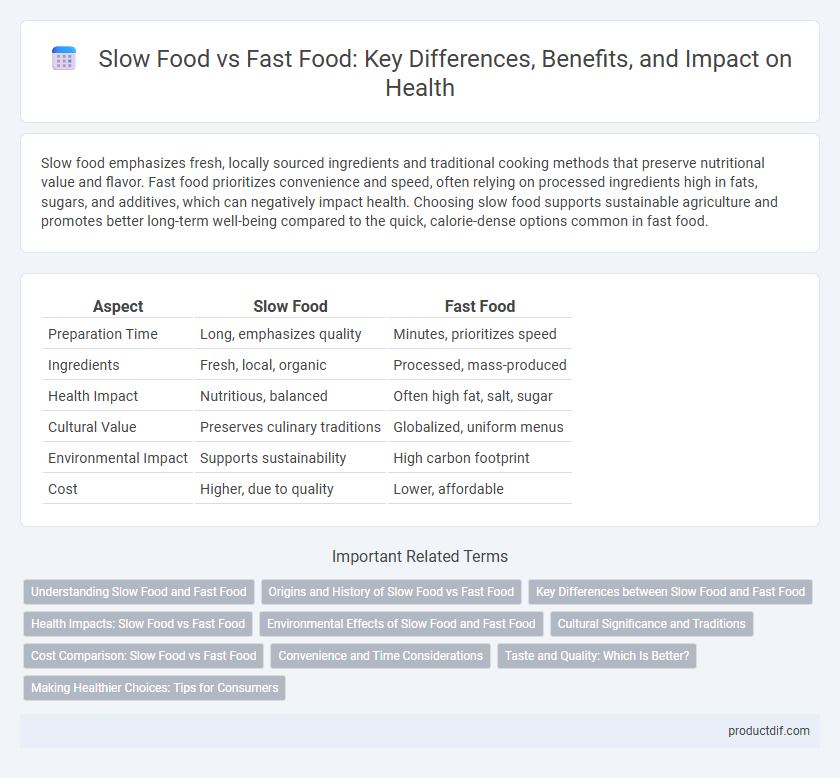Slow food emphasizes fresh, locally sourced ingredients and traditional cooking methods that preserve nutritional value and flavor. Fast food prioritizes convenience and speed, often relying on processed ingredients high in fats, sugars, and additives, which can negatively impact health. Choosing slow food supports sustainable agriculture and promotes better long-term well-being compared to the quick, calorie-dense options common in fast food.
Table of Comparison
| Aspect | Slow Food | Fast Food |
|---|---|---|
| Preparation Time | Long, emphasizes quality | Minutes, prioritizes speed |
| Ingredients | Fresh, local, organic | Processed, mass-produced |
| Health Impact | Nutritious, balanced | Often high fat, salt, sugar |
| Cultural Value | Preserves culinary traditions | Globalized, uniform menus |
| Environmental Impact | Supports sustainability | High carbon footprint |
| Cost | Higher, due to quality | Lower, affordable |
Understanding Slow Food and Fast Food
Slow food emphasizes locally sourced, organic ingredients prepared with traditional cooking methods that promote sustainability and cultural heritage. Fast food prioritizes speed and convenience, using mass-produced, highly processed ingredients that often compromise nutritional value for quick service. Understanding these differences highlights the impact on health, environment, and culinary diversity.
Origins and History of Slow Food vs Fast Food
Slow food originated in Italy during the 1980s as a response to the growing fast food culture, emphasizing traditional cooking methods and local ingredients. Fast food traces back to early 20th-century America, evolving from quick-service diners to global chains like McDonald's prioritizing speed and convenience. Slow food movement promotes biodiversity and sustainability, while fast food revolutionized dining with standardized menus and rapid preparation.
Key Differences between Slow Food and Fast Food
Slow food emphasizes locally sourced ingredients, traditional cooking methods, and longer preparation times to enhance flavor and nutritional value. Fast food prioritizes speed, convenience, and mass production, often using processed ingredients and standardized recipes for quick service. The slow food movement supports sustainability and cultural heritage, while fast food caters to busy lifestyles with affordability and accessibility.
Health Impacts: Slow Food vs Fast Food
Slow food emphasizes fresh, whole ingredients and minimal processing, promoting better digestion and nutrient absorption, which supports long-term health and reduces the risk of chronic diseases. Fast food often contains high levels of saturated fats, sugars, and sodium, contributing to obesity, heart disease, and diabetes due to its processed nature and low nutritional value. Choosing slow food over fast food encourages balanced blood sugar levels, improved metabolism, and enhanced overall well-being.
Environmental Effects of Slow Food and Fast Food
Slow food promotes sustainable agricultural practices by supporting local farmers, reducing carbon emissions, and minimizing food waste through seasonal, organic ingredients. Fast food industries contribute significantly to environmental degradation by relying on industrial farming, high energy consumption, and extensive packaging waste. Choosing slow food over fast food helps lower greenhouse gas emissions and supports biodiversity conservation.
Cultural Significance and Traditions
Slow food preserves cultural heritage by emphasizing traditional cooking methods and locally sourced ingredients, fostering a deep connection to regional history and community. Fast food, in contrast, reflects globalized culture with standardized menus designed for convenience, often leading to the erosion of local culinary traditions. Embracing slow food supports biodiversity and sustains artisanal skills passed down through generations, reinforcing cultural identity.
Cost Comparison: Slow Food vs Fast Food
Slow food generally involves higher upfront costs due to the use of fresh, high-quality ingredients and longer preparation times, which increases labor expenses. Fast food offers lower prices by utilizing mass production techniques, processed ingredients, and minimal cooking times, reducing operational costs. Consumers often pay a premium for the nutritional and taste benefits of slow food, while fast food appeals through affordability and convenience.
Convenience and Time Considerations
Slow food emphasizes fresh ingredients and traditional cooking methods, often requiring longer preparation and dining times, which may not suit busy schedules. Fast food offers unparalleled convenience with quick service and ready-to-eat meals, ideal for individuals seeking time-efficient options. Choosing between slow food and fast food often depends on balancing nutritional quality against the need for speed and accessibility.
Taste and Quality: Which Is Better?
Slow food emphasizes fresh, locally sourced ingredients and traditional cooking methods, resulting in richer, more complex flavors and higher nutritional value. Fast food often prioritizes speed and convenience over ingredient quality, leading to consistent but less nuanced taste profiles. Overall, slow food delivers superior taste and quality due to its careful preparation and attention to ingredient integrity.
Making Healthier Choices: Tips for Consumers
Choosing slow food over fast food promotes better nutrition by emphasizing whole, unprocessed ingredients rich in vitamins and fiber. Opt for meals prepared with fresh vegetables, lean proteins, and whole grains to reduce intake of trans fats, sugars, and sodium commonly found in fast food. Planning meals ahead and cooking at home can help consumers make healthier choices that support long-term wellness and weight management.
slow food vs fast food Infographic

 productdif.com
productdif.com